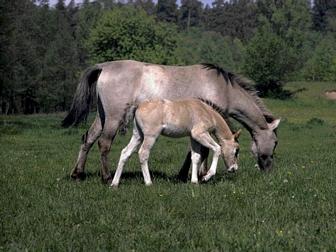
OVERVIEW
The Tarpan is one of the four "primitive horses" existing from the time of the Ice Age. These horses became the foundation breeds for all modern horses. The Tarpan existed somewhere between the Asian steppe horse - Przewalski's Horse - and the thick-legged, browsing Forest horse. It is a swifter moving horse, more lightly built than the other two, and lived in-between the steppes of Ukraine and the forests of Eastern Europe. There is some debate as to whether the modern Tarpan is extinct, preserved, or restored. Some say the horse exists in its pure form on preserves in Poland; others say the last Tarpan died in captivity between 1887 and 1919, and that those on the preserves are a mix of pureblooded Tarpan and local wild Polish peasant ponies.
PHYSICAL DESCRIPTION
The Tarpan stands somewhere around 13 hands high. It has a long, broad head that has a straight to slightly convex profile. The neck is short and thick, the quarters sloped, and the tail set low. The coloration ranges from dun to brown with a black dorsal stripe and black mane and tail. Zebra stripes sometimes occur on the legs and occasionally on the body. The winter coat has been known to turn white in very cold climates.
ORIGIN
Being one of the four founding breeds for modern horses, the Tarpan's origin can only be said to come from the ancient Equus that moved from America to Europe and Asia during the time of the Ice Ages. It was hunted throughout history with the meat being considered a delicacy in the 18th century. Polish peasants also rounded up and broke the Tarpan for light farm work. The last feral Tarpan is said to have been killed in Russia in 1879. Before the "last" captive Tarpan died, the Polish government is said to have rounded up a herd of horses that looked much like the pure Tarpan and set them in two forest preserves. These horses retain much of the Tarpan character whether they are technically pureblooded or not.
INTERESTING FACTS
The Tarpan is extremely brave and fertile. They seem immune to disease and heal injuries without trouble. Tarpan stallions are known to attack domestic breeds when threatened, often fighting successfully to the death. This also led to a particular fierceness shown by hunters of the Tarpan.
INFLUENCES
1. Mongolian Wild Horse
2. Asiatic Wild Horse
For more information:
Ministerstwo Rolnictwa i Gospodarki
Zywnosciowe
U1. Wspolna 30
00-930 Warsaw
POLAND
V. I. Lenin All-Union Academy of
Agricultural Sciences
21 Bolshoi Kharitonievsky pereulok
Moscow 107814
RUSSIA
American Tarpan Studbook Association
1658 Coleman Avenue
Macon GA 31201-6602
Phone: (702) 468-0463